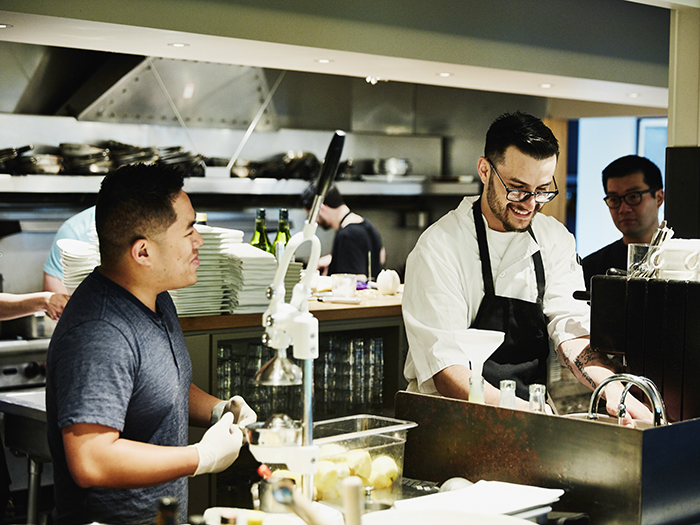
[ad_1]
The 2024 Restaurant Risk Report by AmTrust details what’s driving workers’ comp costs for restaurant operators and how to make meaningful changes in workplace safety.

Restaurants are fast paced. During a lunch or dinner rush, a slow kitchen can become flooded with orders within minutes. Suddenly all the stovetops are lit. The knives are chopping. Cooks and servers are hustling back and forth. The environment is rife with safety risks.
“During peak hours, some obvious safety measures may not be particularly convenient. For example, properly storing a knife that will be used again in a few seconds might seem unnecessary in the moment. The fast-paced nature of the industry is definitely a contributing factor to some safety oversights,” said Matt Zender, senior vice president, workers’ comp strategy, AmTrust Financial.
Then consider the high turnover rate typical of most restaurants. Staff that lack experience, comprehensive training, and familiarity with the rhythm of a restaurant are more prone to injury.
“Tenure matters. When you gain familiarity with your team, you start to anticipate each other’s actions,” Zender said.
The restaurant industry has been able to reduce some liability risks thanks to shifts in demand created by COVID-19. For one, more people opt for delivery over in-person dining, which has given rise to third-party delivery services like UberEats and DoorDash. These services assume any liability risks associated with the delivery, taking some pressure off the restaurant itself.
But workplace injuries remain a significant exposure.
A Guide to Injury Drivers and Prevention

Matt Zender, senior vice president, workers’ comp strategy, AmTrust Financial
AmTrust’s 2024 Restaurant Risk Report breaks down the most common and most costly injuries, and details how operators can help prevent them.
“For this study, we analyzed over 130,000 claims from just the last six years. We share the report with our clients and actively seek their feedback, which has been instrumental in shaping our approach. Based on the feedback we received from our previous reports, we made significant enhancements to the 2024 edition, including a comprehensive section at the end providing tips and solutions for operators to mitigate risks such as strains, cuts, or burns,” Zender said.
“This addition complemented our detailed findings, offering practical advice that operators can readily implement. By incorporating this valuable feedback, we have created a more actionable and impactful report for our clients in the restaurant industry.”
Frequency Vs Severity
Cuts represent the most common injury in restaurants. Of the 130,000 claims analyzed cuts and scrapes made up nearly 32,000 — about 25% of all claims.
However, these claims are the least severe, with an average cost per claim of $1,798.
On the other end of the spectrum are fractures, with the highest average cost per claim of $22,837. These injuries, however, are infrequent, making up just 3% of all studied claims.
Right at the intersection of frequency and severity are strains. The third most common injury after cuts and burns, the 10,694 strains studied made up roughly 8% of all claims. But with an average cost per claim of $10,672, these injuries had the largest impact on workers’ comp costs.
“The economic impact of strains on our book is actually double that of cuts. Strains happen much less frequently but are five times more expensive per claim. This means that strains have the most significant impact on our business,” Zender said.
Musculoskeletal injuries like strains take time to heal and can affect other body parts. A worker with a strained left wrist may, for example, begin to overuse their right hand and wrist to avoid exacerbating their strain, leading to more issues down the road.
Any injury involving multiple body parts, according to the report, will be more costly than injuries involving a single body part. The average payout for a claim involving multiple body parts is about five times higher than the payout for a claim involving just a finger or hand.
Injury Prevention
AmTrust’s report details strategies to reduce the prevalence of workplace injuries in restaurants. When it comes to strains in particular, basic ergonomics can go a long way in preventing injury.
“Restaurant workers perform a lot of repetitive motions. They may be hunched over in the kitchen quite often. They may have to lift heavy objects. They are on their feet a lot. While restaurant operators can’t change the physical demands of the business, they can train employees to perform these tasks in a way that reduces the pressure on their bodies,” Zender said.
This includes proper lifting techniques, such as keeping a load as close to the body as possible and lifting and lowering with the legs, asking for help with heavier loads, and avoiding reaching for things overhead.
Restaurant operators can provide stable footstools to reach higher objects, or redesign storage areas, if possible, to keep items at a lower, more accessible level. Floor mats can be provided to make standing for long periods of time more comfortable.
Operators can also make efforts to rotate workers through certain tasks to limit repetitive motions that lead to strains.
To avoid cuts, scrapes and burns, regular training on proper use and storage of kitchen equipment is critical. Operators can also provide protective gear like steel mesh or Kevlar gloves to protect fingers while slicing, dicing and grating. Non-slip flooring and shoes will reduce falls that can result in accidental cuts and burns, as well as strains and even fractures.
Technology also has a role to play, if operators have the resources to implement it. Sensors, for example, can alert workers if someone is about to come around a corner or through a door, avoiding collisions that result in injury.
“The potential benefits of these technologies are clear. Restaurants operate with certain rhythms, much like a ballet, and sensors could help optimize these rhythms and enhance safety,” Zender said.
“The key to widespread adoption will be finding the right intersection between cost and value. This could involve integrating safety technologies into existing systems, such as personal phones, rather than purchasing separate devices. Once this balance is achieved, the restaurant industry will likely see significant benefits from implementing technology-enabled safety measures.”
The 2024 Restaurant Risk report details these and many more strategies operators can adopt to reduce their injury rates and their workers’ compensation exposure. Find the full report here. &
[ad_2]
Source link